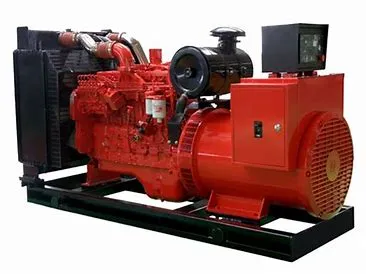Exploring the Future of Natural Gas Generators

In an era marked by evolving energy landscapes and increasing demands for reliable power, the role of natural gas generators is undergoing a significant transformation. Traditionally seen primarily as backup power sources, these workhorses are now at the forefront of technological innovation, promising greater efficiency, lower emissions, and enhanced flexibility. The journey of Exploring the Future of Natural Gas Generators: Technology and Trends isn't just about incremental improvements; it's about a fundamental shift in how we harness this fuel source for power generation. Have you ever stopped to consider how these familiar machines are adapting to meet the challenges of a greener, more connected world?
Technological Leaps Driving Natural Gas Generator Evolution
The core technology underpinning natural gas generators – the internal combustion engine or turbine – has seen remarkable progress in recent years. Manufacturers are pushing boundaries in engine design, combustion control, and materials science to extract more energy from each unit of fuel. For instance, advanced lean-burn technology significantly reduces NOx emissions, a critical environmental concern. Furthermore, interest in advanced natural gas genset technology is leading to systems that can handle varying gas compositions, offering greater fuel flexibility. This isn't just theoretical; these advancements are translating into real-world performance gains, making generators more responsive and better suited for dynamic loads. Frankly speaking, the engines powering tomorrow's generators bear little resemblance to those of a decade ago in terms of sophistication and environmental performance.
Enhancing Efficiency and Reducing Environmental Footprint
Efficiency is a paramount focus in the future of natural gas generation. One key area of development is Combined Heat and Power (CHP), or cogeneration systems. These systems capture waste heat produced during electricity generation and repurpose it for heating or cooling, achieving overall energy efficiencies that can exceed 80%. This dramatically reduces fuel consumption and emissions compared to generating heat and electricity separately. Beyond CHP, innovations in engine management systems, turbocharging, and even micro-grid integration are contributing to substantial efficiency improvements. The drive isn't solely about megawatts produced per cubic foot of gas; it's also about minimizing the environmental impact associated with that generation. It's worth noting that as efficiency increases, so does the economic viability and sustainability of using natural gas for various applications.
The Integration of Natural Gas Generators into Modern Energy Systems
Perhaps one of the most exciting trends is the increasing role of natural gas generators in supporting renewable energy sources like solar and wind power. Due to their inherent variability, renewables often require dispatchable power sources to ensure grid stability. Natural gas generators, particularly advanced reciprocating engine types, can start quickly and ramp up power output rapidly, making them ideal partners for intermittent renewables. This creates hybrid energy systems where natural gas provides reliable backup or peaking power, ensuring a consistent energy supply regardless of weather conditions. Many experts agree that this symbiotic relationship between gas and renewables will be crucial for transitioning to a low-carbon energy future, highlighting the generator's role not just as a standalone unit but as a vital component within a larger, complex energy ecosystem.
Smart Technology and Connectivity in Gas Gensets
The rise of the Internet of Things (IoT) and advanced digital technologies is profoundly impacting natural gas generators. Modern units are equipped with sophisticated sensors and control systems that allow for real-time performance monitoring, predictive maintenance, and remote operation. This connectivity provides invaluable data for optimizing fuel consumption, reducing downtime, and anticipating potential issues before they lead to failures. Think of it as giving the generator a brain; it can analyze its own performance, communicate its needs, and even interact with the wider energy grid. This leap into digital integration is enhancing reliability and reducing operational costs, making the future of natural gas generators smarter and more autonomous than ever before. This trend towards automation and data-driven management is transforming how these assets are deployed and managed across various sectors.
Addressing Emissions: Cleaner Combustion and Aftertreatment
Environmental concerns are driving significant innovation in emission control for natural gas generators. Beyond lean-burn combustion, technologies like Selective Catalytic Reduction (SCR) and exhaust gas recirculation are becoming more common, drastically reducing harmful pollutants like NOx, CO, and particulate matter. Manufacturers are also exploring the potential for blending natural gas with lower-carbon fuels, such as biogas or even hydrogen, further reducing the carbon intensity of the power generated. While natural gas is a fossil fuel, these technological advancements are making it a significantly cleaner option compared to other conventional fuels, bridging the gap as renewable infrastructure continues to expand. The focus is clearly on minimizing the environmental footprint, pushing towards near-zero emission operation in many applications, which is essential for their continued viability in urban or environmentally sensitive areas.
Expanding Applications and Market Drivers
The reliability and improving environmental performance of natural gas generators are expanding their range of applications. While still critical for emergency backup power in hospitals, data centers, and critical infrastructure, they are increasingly being used for peak shaving, grid support, and even primary power in remote locations or micro-grids. The growing need for energy resilience in the face of extreme weather events and grid vulnerabilities is a major market driver. Additionally, the lower and more stable cost of natural gas compared to diesel in many regions makes it an economically attractive option for continuous or frequent use. The demand for reliable backup power solutions is only growing, and natural gas generators are positioned to meet this need with increasingly sophisticated and efficient technology. Interestingly enough, this versatility across different use cases underscores their importance in both developed and developing energy markets.
Future Outlook and Challenges on the Horizon
Looking ahead, the future of natural gas generators appears promising, albeit with challenges. Continued investment in R&D will focus on even higher efficiencies, greater fuel flexibility (including hydrogen blends), and deeper integration with digital energy management platforms. However, navigating evolving environmental regulations and public perception remains crucial. The industry must continue to innovate and communicate the significant strides being made in reducing emissions and enabling the integration of renewables. Policy frameworks that recognize the complementary role of natural gas in achieving energy security and sustainability will also be vital. Overcoming these hurdles requires collaboration across the energy sector, from manufacturers to policymakers and end-users, ensuring that natural gas generation evolves responsibly.
Choosing the Right Natural Gas Generator for Your Needs
With the array of technological advancements discussed, selecting the appropriate natural gas generator requires careful consideration. Factors such as power requirements, intended application (backup, prime, CHP), emission standards, and integration needs (e.g., smart grid compatibility) are all critical. Understanding these technical specifications and matching them to your specific operational requirements ensures optimal performance, efficiency, and compliance. This is where expertise becomes invaluable; navigating the options and ensuring you invest in a system that is not only reliable today but also aligns with future energy trends is key. Choosing wisely means selecting a solution that offers longevity, cost-effectiveness, and minimizes environmental impact over its lifecycle. For instance, if you require a system for a sensitive environment, focusing on models with advanced emission controls would be a priority.
Exploring the future of natural gas generators reveals a dynamic field driven by innovation. From cleaner engines and greater efficiency to smart connectivity and integration with renewables, these technologies are reshaping how we think about gas-fired power. As energy demands grow and the transition to cleaner sources accelerates, natural gas generators are set to play a crucial, evolving role, providing necessary stability and flexibility. Their ability to adapt and improve makes them a vital part of the complex energy puzzle we are solving globally. Understanding these trends is key to making informed decisions about your energy infrastructure, whether for critical backup or grid support. What role do you see natural gas generators playing in your community's energy future?
Navigating the complexities of advanced natural gas generation technology requires expertise. We offer solutions designed with these future trends in mind, focusing on efficiency, reliability, and environmental performance. Our products are developed to meet the increasing demands of modern energy systems, providing robust and sustainable power options for a variety of applications. Whether you're looking for reliable backup, continuous power, or integration into a hybrid system, our technology addresses these critical needs effectively, helping you leverage the benefits of natural gas power while staying ahead of evolving requirements. Contact us to learn more about how our solutions can provide the reliable and efficient power you need.
For more detailed information, please visit our official website: Natural Gas Generators




























































 winning power
winning power



